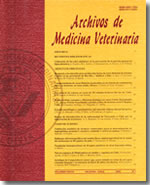Selection criteria comparison for Suffolk Down sheep under range management in central Chile
Main Article Content
Abstract
The aim of this study was to calculate selection indexes for a specialised meat sheep breed, Suffolk Down under range management in Central Chile. A selection index was constructed and relative economic weights for each trait were estimated. Genetic parameters were obtained from the literature and phenotypic parameters were estimated from the available data (N = 330 for PN and TC) of the Suffolk breed from the Estacion Experimental Rinconada de Maipu from the Universidad de Chile. Genetic-economic efficiency (ΔΗ) was estimated as a result of the use of indexes with and without constraints, and when selection is carried out to change a single trait. The traits included in the selection index (IS) were: birth weight (PN) and birth to weaning growth rate (TC). The predicted genetic gain in PN and TC is minimal, due to the moderate to low heritability used (0.15 and 0.17 for PN and TC, respectively). In the simulations, TC was the trait that contributed most to the breeding goal. When PN is restricted, the expected loss is 20% regarding unrestricted selection index, meanwhile selection only for TC could be an effective alternative for sheep growers, since the loss is very small (6.28%) regarding to the selection index and the correlated response on PN would be only 0.75% per generation, what could hardly result in dystocia increase.

